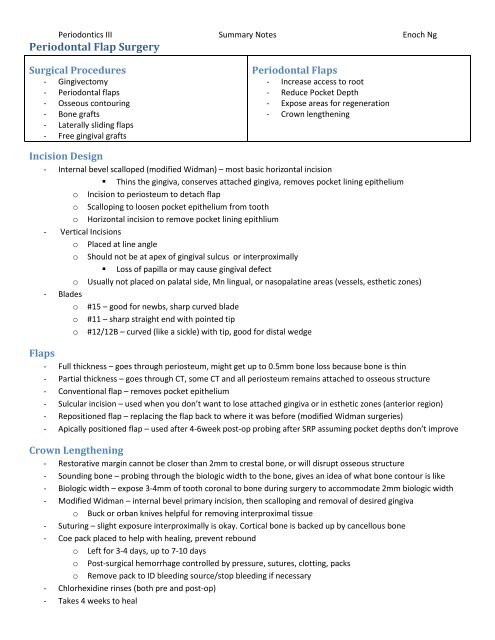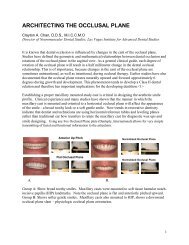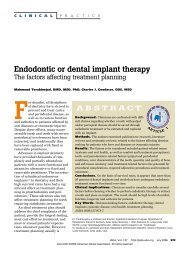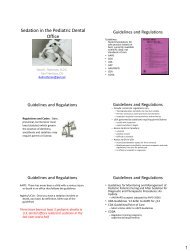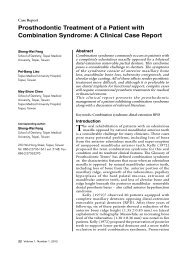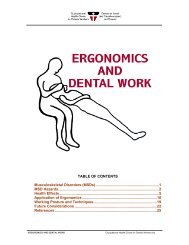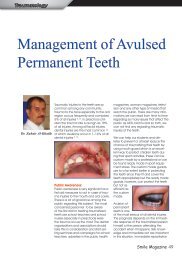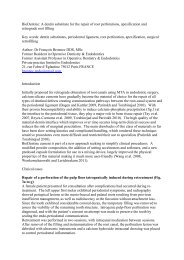Perio_III
Perio_III
Perio_III
You also want an ePaper? Increase the reach of your titles
YUMPU automatically turns print PDFs into web optimized ePapers that Google loves.
<strong>Perio</strong>dontics <strong>III</strong> Summary Notes Enoch Ng<br />
<strong>Perio</strong>dontal Flap Surgery<br />
Surgical Procedures<br />
- Gingivectomy<br />
- <strong>Perio</strong>dontal flaps<br />
- Osseous contouring<br />
- Bone grafts<br />
- Laterally sliding flaps<br />
- Free gingival grafts<br />
<strong>Perio</strong>dontal Flaps<br />
- Increase access to root<br />
- Reduce Pocket Depth<br />
- Expose areas for regeneration<br />
- Crown lengthening<br />
Incision Design<br />
- Internal bevel scalloped (modified Widman) – most basic horizontal incision<br />
• Thins the gingiva, conserves attached gingiva, removes pocket lining epithelium<br />
o Incision to periosteum to detach flap<br />
o Scalloping to loosen pocket epithelium from tooth<br />
o Horizontal incision to remove pocket lining epithlium<br />
- Vertical Incisions<br />
o Placed at line angle<br />
o Should not be at apex of gingival sulcus or interproximally<br />
• Loss of papilla or may cause gingival defect<br />
o Usually not placed on palatal side, Mn lingual, or nasopalatine areas (vessels, esthetic zones)<br />
- Blades<br />
o #15 – good for newbs, sharp curved blade<br />
o #11 – sharp straight end with pointed tip<br />
o #12/12B – curved (like a sickle) with tip, good for distal wedge<br />
Flaps<br />
- Full thickness – goes through periosteum, might get up to 0.5mm bone loss because bone is thin<br />
- Partial thickness – goes through CT, some CT and all periosteum remains attached to osseous structure<br />
- Conventional flap – removes pocket epithelium<br />
- Sulcular incision – used when you don’t want to lose attached gingiva or in esthetic zones (anterior region)<br />
- Repositioned flap – replacing the flap back to where it was before (modified Widman surgeries)<br />
- Apically positioned flap – used after 4-6week post-op probing after SRP assuming pocket depths don’t improve<br />
Crown Lengthening<br />
- Restorative margin cannot be closer than 2mm to crestal bone, or will disrupt osseous structure<br />
- Sounding bone – probing through the biologic width to the bone, gives an idea of what bone contour is like<br />
- Biologic width – expose 3-4mm of tooth coronal to bone during surgery to accommodate 2mm biologic width<br />
- Modified Widman – internal bevel primary incision, then scalloping and removal of desired gingiva<br />
o Buck or orban knives helpful for removing interproximal tissue<br />
- Suturing – slight exposure interproximally is okay. Cortical bone is backed up by cancellous bone<br />
- Coe pack placed to help with healing, prevent rebound<br />
o Left for 3-4 days, up to 7-10 days<br />
o Post-surgical hemorrhage controlled by pressure, sutures, clotting, packs<br />
o Remove pack to ID bleeding source/stop bleeding if necessary<br />
- Chlorhexidine rinses (both pre and post-op)<br />
- Takes 4 weeks to heal


